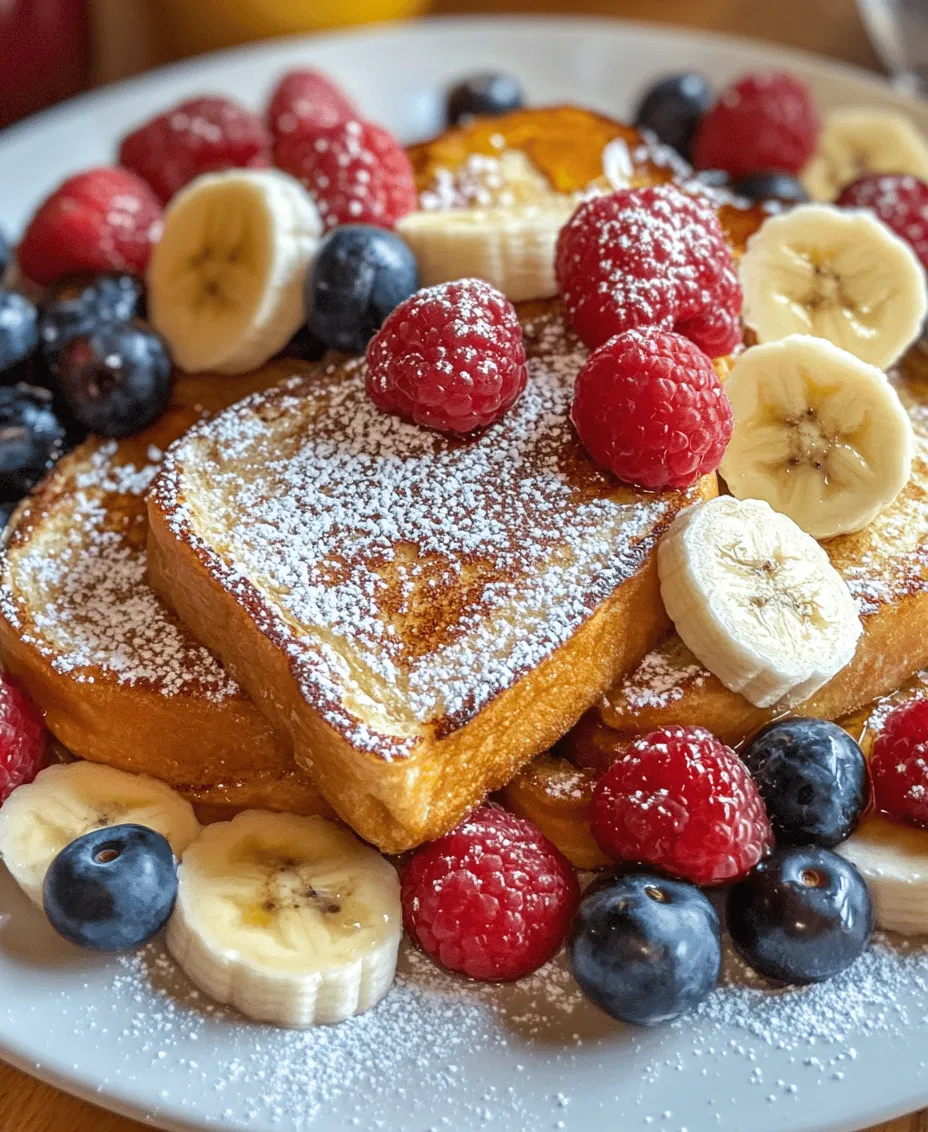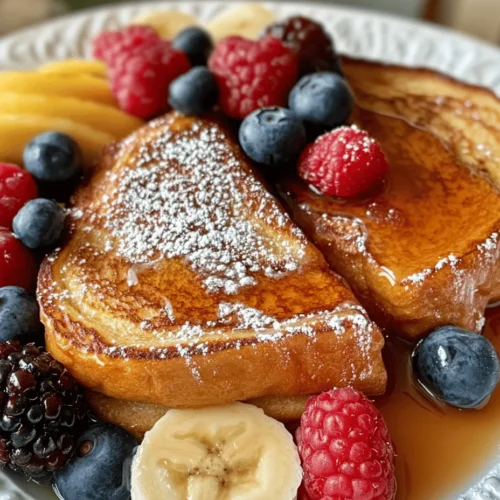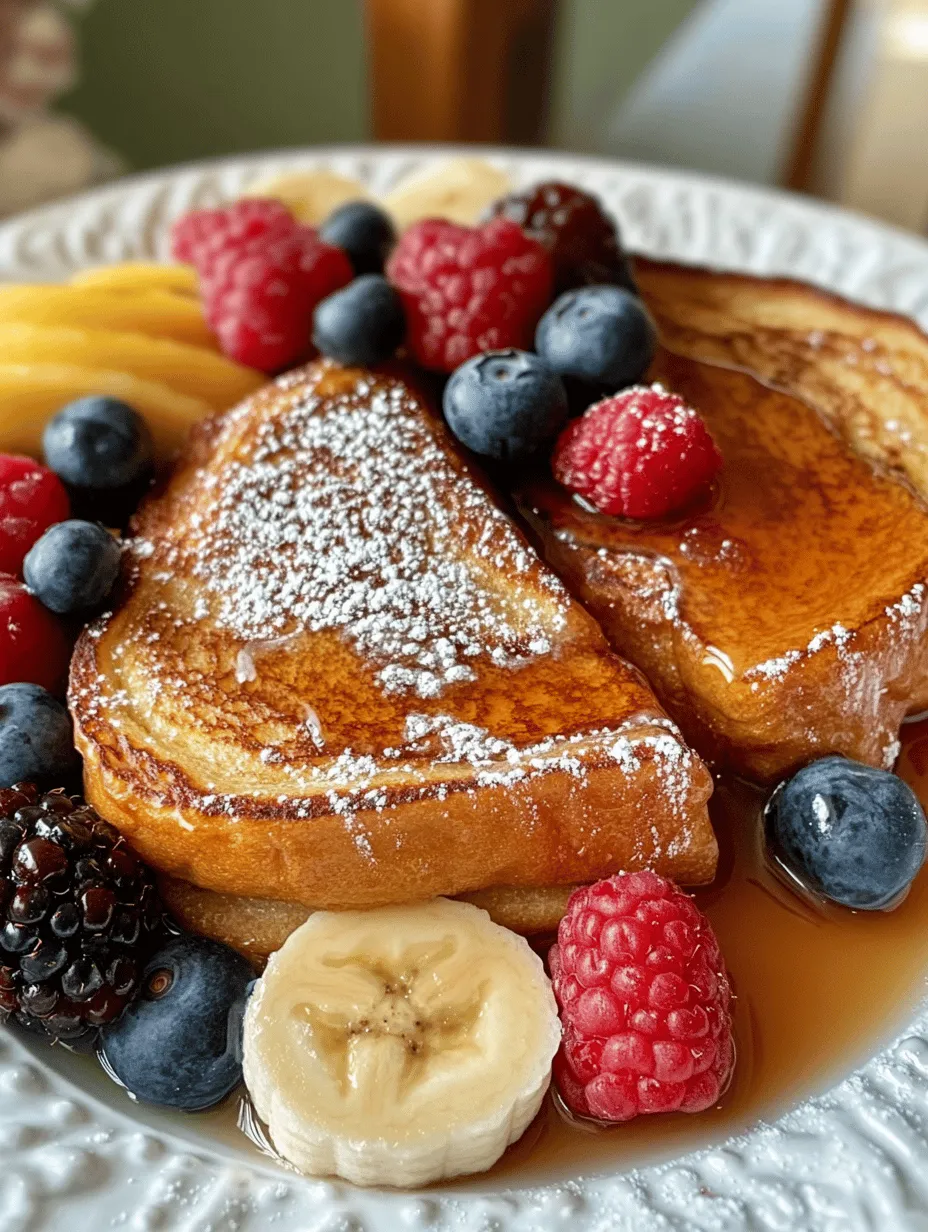Introduction
Exploring the world of breakfast, few dishes evoke the same sense of comfort and nostalgia as classic French toast. This delightful recipe not only pays homage to a beloved morning staple but also offers versatility and richness in flavor. Whether you’re preparing a leisurely brunch or a quick weekday breakfast, this Classic French Toast Delight is sure to please. The warmth of golden-brown slices, a dusting of powdered sugar, and the sweet aroma wafting through your kitchen can transport you to a cozy café in Paris or a bustling country diner. In this article, we will delve into the history of French toast, the importance of ingredient selection, and a step-by-step guide to creating this scrumptious dish, along with serving suggestions that elevate your dining experience.
The History of French Toast
Origins of French Toast: A Culinary Tradition
The roots of French toast can be traced back to ancient civilizations. Historical records suggest that even the Romans had a version of this dish, known as “aliter dulcia,” which translates to “another sweet dish.” This early version simply involved soaking bread in a mixture of milk and egg before frying it. The concept was practical: it transformed stale bread into a delicious meal, ensuring that no food went to waste.
As the centuries rolled on, variations of French toast appeared across Europe, with each culture adding its unique twist. The name “French toast” itself is somewhat misleading; it’s believed to have been popularized in England before making its way to France, where it was known as “pain perdu,” meaning “lost bread.” This term refers to the practice of reviving leftover bread, making it a staple in frugal households.
Variations Around the World: A Global Perspective
French toast is enjoyed worldwide, each culture offering its distinct spin. In Spain, for instance, “torrijas” are typically made during Holy Week, featuring bread soaked in milk and wine, then fried and dusted with sugar. In the United States, variations abound, with recipes that include seasonal flavors like pumpkin spice or holiday twists like eggnog. Other countries, such as Italy and Switzerland, have their versions, showcasing how a simple dish can be adapted to fit local tastes and traditions.
This universal appeal has solidified French toast as a breakfast classic, transcending cultural boundaries while inviting creativity in preparation and presentation.
Evolution of French Toast: From Simple to Gourmet
Over the years, French toast has evolved from a humble dish into a gourmet breakfast item. Chefs and home cooks alike have experimented with different types of bread, flavorings, and toppings, transforming traditional recipes into culinary masterpieces. Today, you might find French toast made with brioche, challah, or even gluten-free bread. Gourmet versions may include exotic ingredients like mascarpone, fruit compotes, or artisanal syrups.
This evolution highlights the dish’s versatility; whether you enjoy it plain, topped with fresh fruit, or smothered in syrup, French toast can be tailored to suit any palate. The balance of sweet and savory, combined with various textures, makes it an enduring favorite for breakfast lovers everywhere.
Understanding the Ingredients
Creating the perfect Classic French Toast Delight begins with understanding the essential ingredients. Each component plays a critical role in achieving that coveted flavor and texture, so let’s take a closer look at what you’ll need.
Choosing the Right Bread: The Foundation of Flavor
The bread you choose is the foundation of your French toast. While traditional recipes often call for white bread, branching out can yield delightful results. Brioche, with its rich, buttery flavor and soft crumb, is a favorite among many. Challah, a slightly sweeter braided bread, also works wonderfully and adds a touch of elegance. For a healthier twist, whole-grain or multigrain breads can be used, offering more fiber and nutrients.
When selecting bread, aim for a loaf that is a day or two old, as slightly stale bread absorbs the egg mixture better without becoming overly soggy. If fresh bread is all you have, simply slice it thicker to prevent it from falling apart during cooking.
Eggs: The Binding Agent for Perfect Texture
Eggs are essential in French toast recipes for binding the ingredients together, providing structure and richness. They create a custard-like mixture when combined with milk, allowing the bread to soak up the flavors. The number of eggs used can vary depending on the quantity of French toast you’re making, but a good rule of thumb is to use one egg for every one to two slices of bread.
For a richer flavor, consider using large eggs, as their yolks add more depth to the dish. If you’re looking for a lighter version, you can substitute one of the eggs with egg whites or use egg alternatives that are suitable for dietary preferences.
Milk Options: Dairy vs. Dairy-Free Alternatives
Milk is another key ingredient that helps create that delicious custard consistency. While whole milk is commonly used, you can experiment with other options, including low-fat milk, almond milk, or oat milk for a dairy-free alternative. Each type of milk brings its unique flavor and texture, so feel free to choose one that aligns with your dietary needs or personal taste preferences.
For an extra creamy texture, consider adding a splash of heavy cream or half-and-half to your milk mixture. This will elevate the richness of your French toast, making it an indulgent treat.
Flavor Enhancers: Vanilla, Cinnamon, and Salt
To elevate your French toast, flavor enhancers are crucial. A splash of vanilla extract adds a warm, inviting aroma and depth to the custard. Ground cinnamon is another classic addition that not only enhances the taste but also gives your French toast a charming, homey scent.
Don’t forget to include a pinch of salt in your mixture. While it may seem counterintuitive, salt helps to balance the sweetness and enhances the overall flavor of the dish.
Cooking Fat: Butter vs. Oil for Optimal Crispiness
When it comes to cooking fat, butter is often the go-to choice for French toast lovers because of its rich flavor. However, for those who prefer a healthier option, a neutral oil, such as canola or coconut oil, can also be used.
The choice of cooking fat can impact the crispiness of the toast. Butter tends to brown more quickly, giving a beautiful golden color, while oil can help achieve a uniform crisp. You can also opt for a combination of both, using butter for flavor and oil to prevent burning.
Step-by-Step Guide to Making Classic French Toast
Now that we’ve covered the history and essential ingredients, let’s dive into the step-by-step guide for making Classic French Toast Delight. This straightforward recipe will walk you through the process of creating this delicious breakfast dish.
1. Gather Your Ingredients: Start by collecting all your ingredients. You’ll need your chosen bread, eggs, milk, vanilla extract, cinnamon, salt, and your preferred cooking fat. Having everything ready will streamline the cooking process.
2. Prepare the Custard Mixture: In a large mixing bowl, whisk together the eggs, milk, vanilla extract, cinnamon, and salt until well combined. Ensure there are no lumps, creating a smooth custard. This mixture is what will soak into the bread, so take your time to achieve the right consistency.
3. Preheat Your Pan: Place a non-stick skillet or griddle over medium heat. If you’re using butter, add a small pat to the pan and let it melt. If using oil, pour a thin layer into the pan, ensuring it coats the bottom evenly.
4. Soak the Bread: Take your slices of bread and dip them into the custard mixture, allowing each side to soak for about 15-20 seconds. Be careful not to soak them too long, as they can become overly soggy. Instead, aim for a nice saturation that will yield a tender yet crisp result.
5. Cook the French Toast: Once the bread is adequately soaked, place it in the preheated pan. Cook each side for about 3-4 minutes or until golden brown. Don’t rush this step; a lower heat will ensure that the inside cooks through without burning the outside. You may need to adjust the heat as you go along to achieve the perfect color.
6. Keep Warm: If you’re making multiple batches, keep the cooked French toast warm in a low oven (around 200°F) while you finish cooking the rest. This will ensure that they stay toasty and warm for serving.
7. Serve and Enjoy: Once all the slices are cooked, serve them warm with your favorite toppings. Classic choices include maple syrup, fresh berries, whipped cream, or a dusting of powdered sugar. The beauty of French toast is that it can be customized to suit your taste preferences.
With these steps, you’ll create a Classic French Toast Delight that not only pleases the palate but also provides an inviting start to your day.
Stay tuned for the next part of this article, where we’ll explore serving suggestions, tips for achieving the best results, and answer some common questions about French toast.

Preparing the Egg Mixture: Achieving the Perfect Blend
To create the quintessential Classic French Toast Delight, the egg mixture is crucial. Start by cracking four large eggs into a medium-sized mixing bowl. Use a whisk or fork to beat the eggs until the yolks and whites are fully combined. This will ensure a uniform texture throughout the toast.
Next, add one cup of whole milk to the eggs. Milk not only enhances the richness of the dish but also provides the necessary moisture for soaking the bread. For those looking for a creamier texture, consider substituting with half-and-half or heavy cream. If you would prefer a lighter alternative, you can opt for low-fat milk or unsweetened almond milk.
To elevate the flavor profile, incorporate a pinch of salt, one teaspoon of pure vanilla extract, and one teaspoon of ground cinnamon into the mixture. The vanilla adds a lovely aroma, while the cinnamon imparts warmth and depth. Whisk the mixture until all ingredients are well combined, ensuring an even distribution of flavors in every slice of French toast.
Preheating the Skillet: Understanding Temperature Control
Temperature control while cooking is essential for achieving that perfect golden-brown crust. Begin by preheating your skillet or griddle over medium heat. This typically takes about 5-7 minutes. A well-preheated surface is crucial; if it’s not hot enough, the bread will absorb too much of the egg mixture and become soggy. Conversely, if it’s too hot, the outside will burn before the inside has cooked through.
To test if the skillet is ready, you can sprinkle a few drops of water onto the surface. If they dance and evaporate almost immediately, your skillet is at the right temperature. Once preheated, add a tablespoon of unsalted butter to the skillet. Allow it to melt completely, coating the surface evenly. This will not only prevent the bread from sticking but also add a delicious buttery flavor that enhances the overall dish.
Soaking the Bread: Techniques for Maximum Absorption
The soaking process is where the magic happens. Take your choice of bread—whether it’s brioche, challah, or Texas toast—and slice it into generous pieces about 1-inch thick. This thickness helps the bread absorb the egg mixture without falling apart.
Submerge each slice of bread into the egg mixture, allowing it to soak for about 30 seconds on each side. Ensure that the bread is adequately coated but not overly saturated. If left too long, the bread may become too soggy to hold its shape during cooking.
A helpful tip is to use a shallow dish for soaking, which allows for easier handling. After soaking, gently shake off any excess mixture before placing the slices on the skillet to avoid excessive moisture in the pan.
Cooking Techniques: Achieving the Ideal Golden Brown
Once your bread slices are adequately soaked and the skillet is ready, it’s time to cook! Carefully place the soaked bread slices onto the skillet, ensuring not to overcrowd the pan. This allows for even cooking and prevents steaming.
Cook each slice for approximately 3-4 minutes on one side. You’ll know it’s time to flip when the edges look firm and the bottom surface has developed a beautiful golden brown color. Using a spatula, gently flip the slices and cook for another 2-3 minutes on the other side.
If you like your French toast extra crispy, you can increase the cooking time slightly or even lower the heat to allow for a longer cooking period without burning. Once both sides are perfectly browned, transfer the finished slices to a plate, and keep them warm in a low oven (around 200°F) while you finish cooking the remaining slices.
Serving Suggestions: Presentation is Key
Presentation plays an essential role in enjoying your Classic French Toast Delight. Stack the slices in a staggered manner on a serving plate, creating height and interest. To add a pop of color and freshness, garnish with fresh berries such as strawberries, blueberries, or raspberries. The vibrant colors not only enhance the visual appeal but also provide a refreshing contrast to the rich flavors of the toast.
For a finishing touch, dust the top with powdered sugar using a fine mesh sieve. This adds a touch of elegance and sweetness without overwhelming the dish. Drizzle warm maple syrup over the stack just before serving, allowing it to cascade down the sides.
Topping Options: Maple Syrup, Powdered Sugar, and Fresh Fruit
When it comes to toppings, the options are nearly endless. The classic choice is a generous drizzle of pure maple syrup, which adds a rich sweetness that complements the eggy, cinnamon-spiced toast beautifully.
For those who enjoy a lighter touch, a dusting of powdered sugar can provide just the right amount of sweetness without overshadowing the flavor of the toast.
Fresh fruit is another excellent topping choice. Sliced bananas, juicy strawberries, or tart raspberries can add a refreshing contrast. You can also macerate the fruit in a bit of sugar and lemon juice for an extra burst of flavor.
Creative Additions: Nuts, Whipped Cream, and Spices
If you want to take your French toast to the next level, consider adding creative toppings. Chopped nuts such as pecans or walnuts can add a delightful crunch and nutty flavor. For a decadent finish, a dollop of whipped cream can add richness and creaminess that elevates the dish.
You might also experiment with spices, such as a sprinkle of nutmeg or cardamom, to enhance the flavor. These additions can give your French toast a unique twist, making it a fun breakfast option that can be tailored to suit any taste preference.
Pairing Suggestions: Beverages that Complement Your Meal
Pairing your Classic French Toast Delight with the right beverage can enhance your dining experience. A steaming cup of freshly brewed coffee or espresso is a classic choice, providing a bold flavor that balances the sweetness of the toast.
For those who prefer tea, a light herbal or chai tea can be a lovely accompaniment, offering warmth and comfort. If you’re in the mood for something refreshing, a glass of freshly squeezed orange juice can provide a zesty contrast that brightens the meal.
Healthier Alternatives and Modifications
For those looking to modify the Classic French Toast Delight to fit dietary restrictions or preferences, there are several options available.
Gluten-Free Bread Options for Dietary Restrictions
If you or your guests are gluten-sensitive, substituting regular bread with gluten-free bread is a great option. There are many delicious gluten-free bread varieties available that will still absorb the egg mixture beautifully, allowing you to enjoy the same classic flavors without compromising on taste.
Low-Sugar Variants: Natural Sweeteners
To reduce sugar content, consider substituting traditional sweeteners with natural sweeteners such as honey, agave syrup, or coconut sugar. These alternatives provide sweetness while offering unique flavor profiles that can enhance the overall dish.
Dairy-Free Versions: Substitutes for Milk and Butter
For those following a dairy-free lifestyle, almond, soy, or oat milk can be used in place of whole milk. For the butter, coconut oil or a dairy-free margarine can work just as effectively, providing a rich flavor without the dairy.
Conclusion
Classic French Toast Delight is more than just a breakfast option; it’s a versatile dish that can be customized to suit any palate or dietary requirement. With its rich history, simple preparation, and endless variations, this recipe is bound to become a cherished part of your breakfast repertoire. Whether enjoyed on a leisurely Sunday morning or as a quick weekday treat, the experience of savoring this classic dish brings warmth and joy to the table. Embrace the delightful simplicity of French toast and indulge in a timeless breakfast tradition that continues to create lasting memories.
So gather your loved ones, whip up this delicious treat, and let each bite transport you to a cozy kitchen filled with the irresistible aroma of cinnamon and vanilla. Enjoy your Classic French Toast Delight today!


